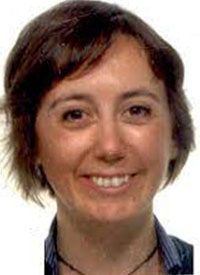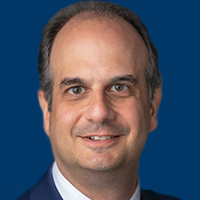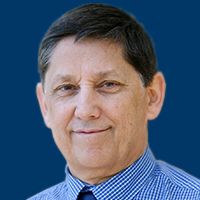Reduced-Dose Lenalidomide Maintenance Regimen Recommended for Elderly Patients With Myeloma
Intermediate-fit, elderly patients with newly diagnosed multiple myeloma were found to have similar outcomes with a reduced dose of lenalidomide maintenance therapy after completing 9 cycles of lenalidomide plus dexamethasone compared with standard, continuous dexamethasone.
Alessandra Larocca, MD, PhD

Intermediate-fit, elderly patients with newly diagnosed multiple myeloma were found to have similar outcomes with a reduced dose of lenalidomide (Revlimid) maintenance therapy after completing 9 cycles of lenalidomide plus dexamethasone (Rd) compared with standard, continuous Rd, according to findings from a phase 3 study (NCT02215980) published in Blood.1
At a median follow-up of 37 months, the median event-free survival (EFS) was 10.4 months with Rd followed by lenalidomide (Rd-R) vs 6.9 months with continuous Rd (HR, 0.70; 95% CI, 0.51-0.95; P = .02).
Moreover, the EFS benefit was maintained beyond cycle 9 of treatment at 19.8 months with Rd-R vs 10.6 months with Rd (HR, 0.55; 95% CI, 0.32-0.93; P = .03).
No significant difference in EFS was observed in patients who were considered intermediate-fit based on age (median EFS = 8.1 months) vs comorbidities or functional impairment (median EFS = 7.6 months; HR 0.93; 95% CI, 0.68-1.28; P = .67).
“Myeloma patients are a very diverse population, including fit patients who may tolerate full-dose treatments, and intermediate-fit and frail patients who are more susceptible to adverse events [AEs] that may negatively affect the duration and outcome of treatment due to the presence of comorbidities and functional impairments, thus requiring an adapted therapy,” said lead study author Alessandra Larocca, MD, PhD, a consultant physician of the Division of Hematology in the Department of Hematology/Oncology at the Azienda Ospedaliero-Universitaria Città della Salute e della Scienza di Torino, in Turin, Italy.2
“Our study shows, for the first time, that reducing the dose or intensity of treatment is a feasible option and produces similar outcomes as standard dose treatments for intermediate-fit patients,” Larocca added.
Continuous Rd is a standard treatment option for patients with multiple myeloma who are ineligible for autologous stem cell transplant and has been demonstrated to be safe and effective for elderly patients with newly diagnosed disease.
However, data from the FIRST trial showed that patients with transplant-ineligible multiple myeloma who were older than 75 years had suboptimal responses to Rd compared with younger patients.3
Patients from 33 Italian centers were randomized 1:1 to receive Rd-R, given as nine 28-day induction cycles of lenalidomide at 25 mg daily for 21 days plus dexamethasone on days 1, 8, 15, and 22 followed by 10 mg per day of lenalidomide maintenance in 21-day cycles until disease progression or intolerance, vs continuous Rd.1
All patients received mandatory anti-thrombotic prophylaxis with aspirin or low molecular weight heparin based on thrombotic risk. Antibacterial prophylaxis was recommended in instances of neutropenia or recurrent infections.
Patients were allowed to receive granulocyte colony–stimulating factor (G-CSF), blood, and platelet transfusions while on study treatment.
EFS, defined as progression/death for any cause, lenalidomide discontinuation, any hematologic grade 4 or non-hematologic grade 3 or 4 AEs, served as the primary end point of the study. Key secondary end points included progression-free survival (PFS), overall survival (OS), overall response rate (ORR), and incidence of dose reductions and drug discontinuation.
Baseline patient characteristics were similar between arms. Across all patients, the median age was 76 years (range, 73-78), and the majority were male (51%). Most patients had an ECOG performance status of 1 (52%) and more than half were considered intermediate-fit because of age (52%) rather than geriatric impairment.
Overall, 210 patients enrolled; 11 did not meet the inclusion criteria and were excluded from the study. Of the 101 patients randomized to Rd-R, 67 discontinued treatment for reasons including death (n = 7 including 4 toxic deaths), progression (n = 34), AEs (n = 18), loss of follow-up (n = 2), decline of medical conditions (n = 4), patient request (n = 1), and other (n = 1). Of the 98 patients randomized to Rd, 74 discontinued treatment for reasons including death (n = 9 including 7 toxic deaths), progression (n = 34), AEs (n = 22), loss of follow-up (n = 2), decline of medical conditions (n = 5), patient request (n = 1), and other (n = 1).
At the time of the data cut-off, 34 patients who were randomized to Rd-R remained on therapy and 43 patients progressed to receive second-line therapy. In the Rd cohort, 24 patients remained on therapy at the study cutoff and 43 progressed to second-line therapy.
Additional results revealed that the median PFS was 20.2 months with Rd-R and 18.3 months with Rd (HR, 0.78; 95% CI, 0.55-1.1; P = .16). No difference in median PFS was observed between Rd-R and Rd treatment for patients still on therapy after 9 cycles (HR, 0.73; 95% CI, 0.44-1.18; P = .19).
A trend toward improved PFS with Rd-R was discovered among patients with standard-risk disease (HR, 0.62; 95% CI, 0.39-1.00) but not in high-risk patients (HR, 1.10; 95% CI, 0.47-2.55).
The median OS was not reached; the 3-year OS rate was 74% with Rd-R and 63% with Rd (HR, 0.62; 95% CI, 0.37-1.03; P = .06).
The ORR was 78% with Rd-R vs 68% with Rd (P = .15). The rates of very good partial response or better were 51% vs 39%, respectively (P = .09).
The median time to response was similar between arms at 2 months with Rd-R vs 1.9 months with Rd. The median time to best response was 7.5 months vs 6.8 months, respectively.
Additionally, 17% of patients who received Rd-R who were still on therapy after 9 cycles improved their response thereafter compared with 25% of patients who received Rd (P = .2).
Regarding safety, the median duration of lenalidomide treatment was 17.3 months with Rd-R vs 12.8 months with continuous Rd. The median duration of dexamethasone treatment was 8.6 months vs 11.7 months, respectively.
In the Rd-R cohort, 26% of patients reported at least 1 grade 3 or higher hematologic AE vs 20% in the Rd cohort (P = .40); grade 3 or greater neutropenia occurred in 21% and 18% of patients, respectively. Additionally, 33% and 43% of patients, respectively, reported at least 1 grade 3 or higher non-hematologic AE (P = .15). The most frequently observed grade 3 or higher non-hematologic toxicities included infections (10% vs 12%, respectively), constitutional AEs (3% vs 12%, respectively), dermatologic AEs (7% vs 3%, respectively), and central nervous system AEs (2% vs 6%, respectively).
Grade 3 or greater thromboembolic events occurred in 1% and 4% of patients, respectively, and grade 3 or greater peripheral neuropathy was not significant in either arm.
Among patients still on treatment after cycle 9, 17% and 25% of patients in the Rd-R and Rd arms had at least 1 grade 3 or higher non-hematologic event, respectively (P = .28), the most frequent of which were fatigue (1% vs 3%, respectively) and diarrhea (3% vs 7%, respectively).
Regarding supportive care medications, G-CSF was administered in 20% of patients receiving Rd-R and 17% of patients receiving Rd (P = .72). Overall, 32% of patients received low-molecular weight heparin, 33% received aspirin, 9% received warfarin, and 3% did not receive any prophylactic therapy. The use of prophylactic treatment was unknown in 23% of patients.
Regarding secondary malignancies, one instance each of pancreatic neoplasm and Bowen disease was observed in the Rd-R cohort vs one instance each of prostate cancer and Hodgkin lymphoma in the Rd cohort. Additionally, in the Rd cohort, one patient was diagnosed with gastric cancer shortly after beginning cycle 1 of therapy.
In the Rd-R cohort, 24% of patients discontinued lenalidomide and 45% required at least one lenalidomide dose reduction vs 30% and 62% in the Rd cohort, respectively.
During the first 60 days from the start of treatment, 9% of all patients required early drop-out because of toxicity (50%) and toxic deaths (16%), decline of patient conditions or loss of follow-up (17%), death not related to progressive disease (11%), and progressive disease (6%).
In the Rd-R group, 17% of patients died from causes other than progressive disease. Thirteen of these deaths were found to be related to study treatment. In the Rd-R cohort, causes of death included pneumonia (n = 2), chronic obstructive pulmonary disease exacerbation (n = 1), Escherichia coli (E coli) infection (n = 1), and sepsis (n = 1). In the Rd cohort, the causes of death included sepsis (n = 3), E. coli infection (n = 1), post-surgical infection (n = 1), respiratory failure (n = 1), cardiac arrest (n = 1), and heart failure (n = 1). Other causes of death in the overall population included decline in medical conditions (n = 5), accidental death (n = 3), unknown (n = 13), and other diseases (n = 6).
At the time of the data cut-off, 34% of patients in the R-Rd arm and 24% of patients in the Rd arm remained on therapy. Of the 71% of patients who discontinued treatment, progressive disease and toxicity were cited as the main reasons.
Ongoing trials are evaluating “frailty-adjusted,” steroid-free regimens to further personalize treatment for older patients, Larocca and co-authors wrote in the publication.
“We expect [that] the results of this study may help to improve and optimize the treatment of elderly patients who may be at greater risk of treatment toxicity and poor survival due to their age or comorbidities,” Larocca concluded.
References
- Larocca A, Bonello F, Gaidano G, et al. Dose/schedule-adjusted Rd-R vs continuous Rd for elderly, intermediate-fit, newly diagnosed multiple myeloma patients. Blood. Published online March 19, 2021. Accessed April 19, 2021. doi:10.1182/blood.2020009507
- Study: older multiple myeloma patients can be spared of long-term steroids. American Society of Hematology. News release. Published March 19, 2021. Accessed April 19, 2021. https://bit.ly/3svCFaL.
- Facon T, Dimopoulos MA, Dispenzieri A, et al. Final analysis of survival outcomes in the phase 3 FIRST trial of up-front treatment for multiple myeloma. Blood. 2018;131(3):301-310. doi:10.1182/blood-2017-07-795047



